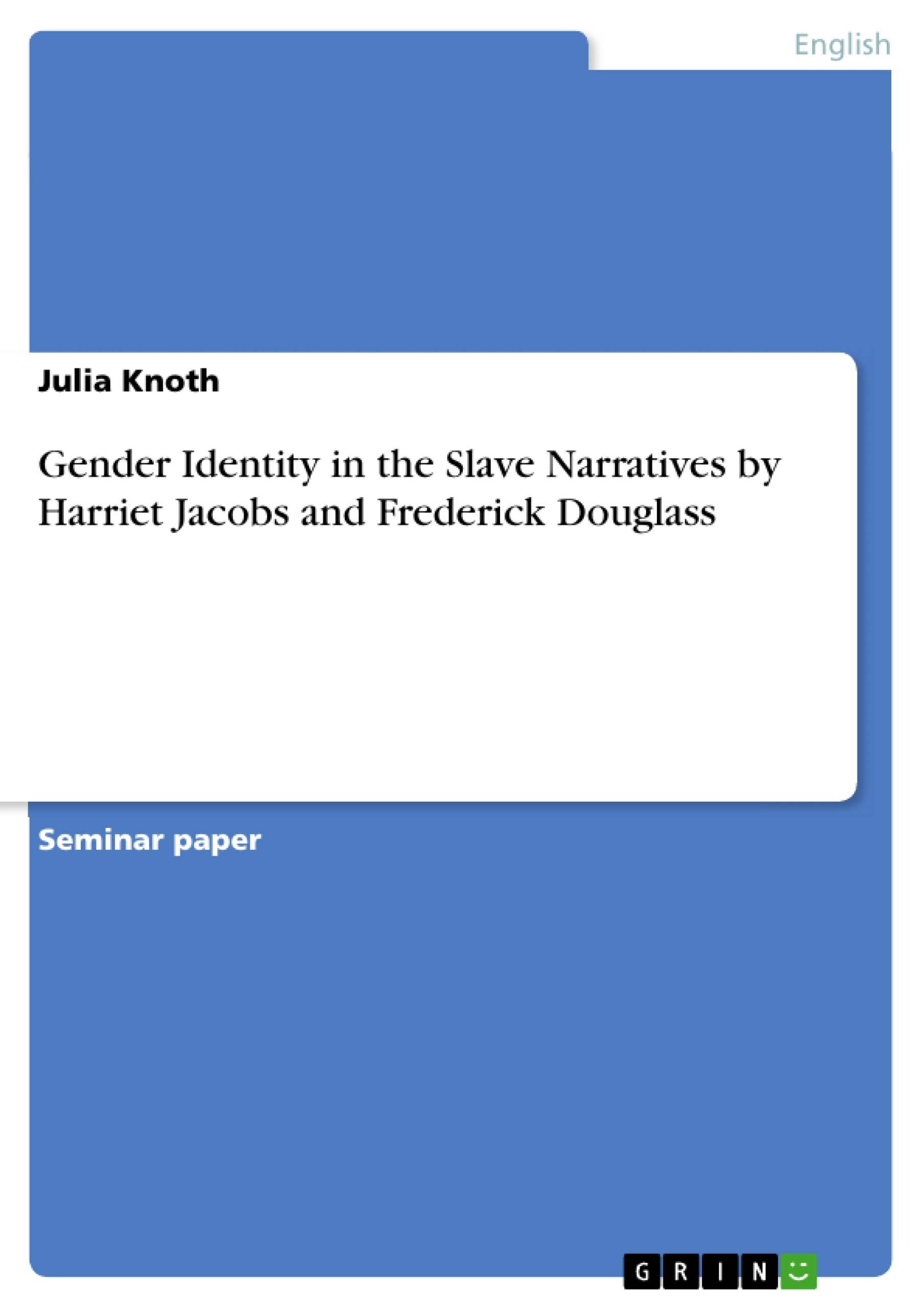Douglass's and Jacob's slave narratives deal with the reconstruction of identity. The recreation of Frederick Douglass's own identity is seen as an “argument for an end to slavery's denial of individuality and creativity”. This process of reconstructing identity is closely connected with the depiction of gender. Thus, the main focus of this term paper is placed on the formation of gender identity in the two slave narratives. The concept of gender can be defined as “the relationship between biological sex and behavior”.
The leading question of this paper is: How does the image of black femininity and black masculinity portrayed in the two slave narratives correspond with the concept of womanhood and manhood prevailing at the time?
In the course of this paper I will attempt to show that the two slave narratives serve as an example of individual self-fashioning, attempting to portray themselves as truly masculine or feminine and conforming to gender roles, at the same time reinventing these prevailing concepts. Society expects people to behave according to norms and values typical for a certain time. Thus, the first chapter gives an overview of gender stereotypes in the 19th century, which will subsequently be linked to the slave narratives.
Creating a female identity as a slave suggests to include the category of sexuality, as female slaves often suffered from oppression and sexual abuse. However, this only offers a limited view and there are other significant dimensions connected to female identity. Therefore, Harriet Jacob's Incidents in the Life of a Slave Girl will also be analyzed in terms of motherhood and interdependence. The creation of male identity in Douglass's Narrative will then be analyzed comparatively by looking at his desire for freedom and how he copes with feminization and dehumanization of male slaves, his fight for independence, and his isolation in reference to his family and other slaves.
Inhaltsverzeichnis (Table of Contents)
- Introduction
- Gender Stereotypes: Womanhood and Manhood in the 19th Century
- Black Femininity in Harriet Jacobs' Incidents in the Life of a Slave Girl
- Sexuality
- Motherhood
- Interdependence
- Black Masculinity in Frederick Douglass' Narrative of the Life of Frederick Douglass, an American Slave
- The Search for Freedom: Coping with Feminization and Dehumanization
- Independence and Autonomy
- Isolation
- Conclusion
Zielsetzung und Themenschwerpunkte (Objectives and Key Themes)
This term paper analyzes the slave narratives of Harriet Jacobs and Frederick Douglass, focusing on the formation of gender identity within the context of 19th-century American slavery. It explores how these narratives portray black femininity and masculinity in relation to prevailing societal norms and expectations.
- The reconstruction of identity as a means to challenge the dehumanization of slavery.
- The interplay of race, gender, and sexuality in shaping individual experiences of slavery.
- The challenges faced by enslaved individuals in conforming to or defying gender roles.
- The impact of slavery on the development of black female and male identities.
- The use of narrative as a tool for resistance and self-expression.
Zusammenfassung der Kapitel (Chapter Summaries)
The introduction provides an overview of the historical context of slavery in 19th-century America, emphasizing the importance of slave narratives as primary sources for understanding the experience of enslavement. It introduces the narratives of Harriet Jacobs and Frederick Douglass as key documents in the abolitionist movement and highlights their focus on reconstructing identity.
Chapter 2 examines the dominant gender stereotypes prevalent in 19th-century American society, highlighting the concept of “true womanhood” and its limitations for enslaved women. It explores the complex interplay of race, gender, and sexuality, emphasizing how these categories intersected to shape the experiences of enslaved individuals.
Chapter 3 focuses on the portrayal of black femininity in Harriet Jacobs's Incidents in the Life of a Slave Girl. It examines the themes of sexuality, motherhood, and interdependence as they relate to the experience of enslaved women. The chapter explores how Jacobs challenges the prevailing norms of femininity while simultaneously navigating the realities of her enslaved life.
Chapter 4 analyzes the depiction of black masculinity in Frederick Douglass's Narrative of the Life of Frederick Douglass, an American Slave. It explores how Douglass confronts the feminization and dehumanization of male slaves through his struggle for freedom, independence, and autonomy. The chapter also examines the challenges Douglass faces in navigating his relationship with his family and other enslaved individuals.
Schlüsselwörter (Keywords)
This term paper explores the intersection of gender identity, race, and slavery through the lens of the slave narratives of Harriet Jacobs and Frederick Douglass. Key themes include black femininity and masculinity, the cult of true womanhood, the search for freedom, coping with feminization and dehumanization, independence and autonomy, and the construction of identity in the context of slavery.
- Quote paper
- Julia Knoth (Author), 2015, Gender Identity in the Slave Narratives by Harriet Jacobs and Frederick Douglass, Munich, GRIN Verlag, https://www.grin.com/document/423943



